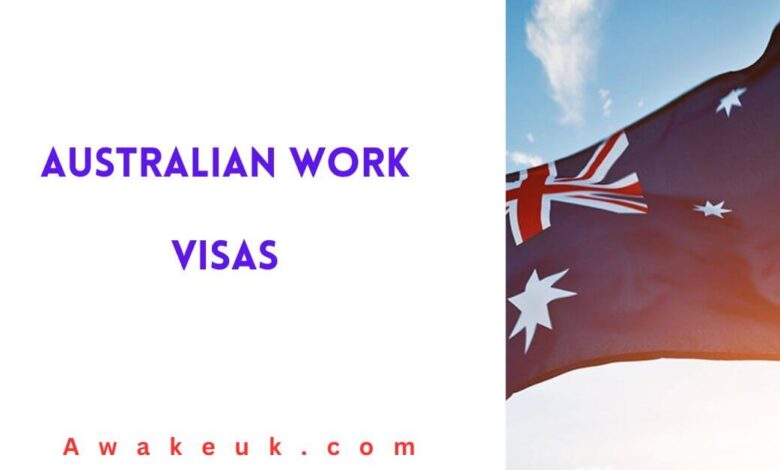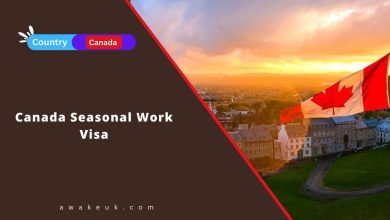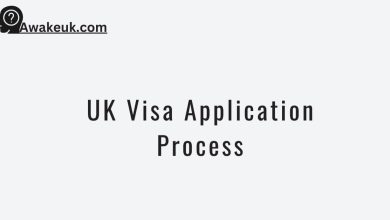Australian Work Visas 2024 – Types of Work Visas

Australia is the second-richest country in the world and has the worst skills shortage. Australia has a lot of different types of work visas that let foreign workers come to live and work there permanently or temporarily. Learn about Australian work visas and the different kinds of work visas for people from other countries. Which type of work visa is best for you? Which Australian work visas don’t need a job offer or sponsorship? Find out everything you need to know about them and see what they need.
There are work cards that don’t need a sponsor and are based on points. If you meet the requirements, all you have to do is apply. As long as you meet the requirements, you can apply for any type of work visa through the migration program if you want to stay in Australia and work. Here is a full list of all the Australian work visas.
Read Also: UAE Standard Work Visa – Benefits and Types
Types of Australian Work Visas:
While there are different kinds of work visas for Australia, these are the most common ones:
| Type of Work Visas | Job offer/Sponsorship Required? |
|---|---|
| Skilled Independent visa (subclass 189) | No |
| Skilled Regional visa (subclass 887) | No |
| Temporary Graduate visa (subclass 485) | No |
| Skilled – Recognised Graduate visa (subclass 476) | No |
| Skilled Regional (Provisional) visa (subclass 489) | No |
| Regional Sponsor Migration Scheme (subclass 187) | Yes |
| Employer Nomination Scheme visa (subclass 186) | Yes |
| Skilled Nominated visa (subclass 190) | Yes |
| Temporary Skill Shortage visa (subclass 482) | Yes |
| Business Innovation and Investment (Provisional) visa (subclass 188) | Yes |
Benefits of Australian Work Visas:
- High-Quality Living Standards: Australia has gained recognition for its exceptional quality of life, encompassing outstanding healthcare, education, and infrastructure. Possession of a work visa grants access to these advantages.
- Strong Economy: Australia possesses a robust and diverse economy that offers prospects in numerous sectors, including education, healthcare, mining, and information technology. Individuals who possess work visas are eligible to apply for these employment prospects.
- Professional Growth: Engaging in employment in Australia can augment one’s career opportunities through the acquisition of global work experience and the introduction to diverse business methodologies and technologies.
- Pathway to Permanent Residency: Numerous work visas issued in Australia may function as a means to obtain permanent residency. In addition to social security benefits and the ability to live and work in Australia indefinitely, permanent residents are granted access to public healthcare.
- Family Inclusion: A considerable number of Australian work visas permit visa holders to accompany dependent children and spouses. Additionally, relatives may study and work in Australia.
- Cultural Diversity: With a variegated population, Australia is a multicultural nation. Working and residing in such an environment fosters personal development and enriches one’s cultural experiences.
- Work-Life Balance: Work-life balance is a highly regarded value in Australia, which is exemplified through the provision of flexible work schedules, ample vacation time, and an emphasis on recreational pursuits and outdoor engagements.
- World-Class Education: Australia provides exceptional educational opportunities for parents with children, encompassing primary and secondary schools, esteemed universities, and vocational training establishments.
- Employee Rights and Protections: Australian labor laws guarantee equitable treatment for workers by establishing provisions for a minimum wage, secure working conditions, and safeguards against unjust termination.
- Healthcare System: Australians with work visas are granted access to a healthcare system of exceptional quality. Medicare, Australia’s public health insurance program, may also afford coverage to you, contingent upon the form of visa.
- Natural Beauty and Way of Life: Australia’s coastlines, mountains, and national parks are among its renowned natural beauty. A high quality of life and a variety of outdoor activities are available to work visa holders.
- Opportunities for Networking: Engaging in employment in Australia presents the prospect of establishing a professional network within an international setting, which may prove to be advantageous in terms of future collaborations and career prospects.
- Skill Development: Gaining experience in a different work environment and acquiring new skills through employment in Australia will increase your employability and foster your professional development.
- World Mobility: Professional expertise acquired in Australia may be held in high regard abroad, thereby potentially facilitating access to employment prospects in other nations.
List of Australian Work Visa Without Job and Sponsorship:
- Skilled Independent visa (subclass 189)
- Skilled Regional visa (subclass 887)
- Temporary Graduate visa (subclass 485)
- Skilled – Recognised Graduate visa (subclass 476)
- Skilled Regional (Provisional) visa (subclass 489)
1# Skilled Independent visa (subclass 189) – Popular
The Skilled Independent visa (subclass 189) is based on points and lets people live and work permanently anywhere in Australia. You must have a job that is on the list of skilled jobs that apply.
- You don’t need a supporter or someone to put you forward.
- You can apply even if you don’t have a job offer or nomination.
- You have to be asked to apply.
- It’s only open to people under 45.
- Stay: Permanently
- Processing Time: 5 Months
- Link: Visit Here
2# Skilled Regional visa (subclass 887)
For people who have lived and worked in rural Australia before, the Skilled rural visa (subclass 887) is a permanent visa that lets them live and work in Australia.
- You don’t need a vote or a backer.
- You can apply even if you don’t have a job offer or nomination.
- To be accepted, you must be younger than 45.
- Stay: Permanently
- Processing Time: 4 Months
- Link: Visit Here
3# Temporary Graduate visa (subclass 485)
There are three types of Temporary Graduate visa (subclass 485).
- Graduate Work Stream
- Post Study Work Stream
- Second Post-Study Work Stream
This visa (485), called the Temporary Graduate visa, is for foreign students who just graduated from an Australian university. You can live, study, and work in Australia for a short time.
- You don’t need a supporter or someone to put you forward.
- You can apply even if you don’t have a job offer or nomination.
- To be accepted, you must be younger than 50.
- Stay: Temporary for 24 Months
- Processing Time: Less than 1 day
- Link: Visit Here
4# Recognised Graduate visa (subclass 476) – Popular
The Australian Subclass 476 Visa lets foreign college graduates who don’t have a job offer in Australia come to Australia. They can come to Australia and work here. For this visa, they don’t need a job offer, a sponsor, or the chance to work.
You can come to Australia with this visa even if you don’t have a job offer. I wrote an in-depth post about the Australia 476 Work Visa.
- You don’t need a sponsor or nominator
- You do not need a Job offer
- You don’t need work experience, proof of financial
- Stay: Temporary for 18 Months
- Link: Visit Here
5# Skilled Regional (Provisional) visa (subclass 489)
With this short-term visa, skilled workers can live and work in country Australia for up to 4 years. It might take a long time to get this visa. Because it takes a long time to understand.
- You don’t need a sponsor or nominator
- You do not need a Job offer or nomination to apply
- Stay: 4 Years
- Processing Time: 44 Months
- Link: Visit Here
List of Australian Work Visa that requires Job and Sponsorship
All of these visas need either a nomination or a job offer from an Australian company. You can only get these visas if you have a job offer that is still valid.
- Regional Sponsor Migration Scheme (subclass 187)
- Employer Nomination Scheme visa (subclass 186)
- Skilled Nominated visa (subclass 190)
- Temporary Skill Shortage visa (subclass 482) – Popular one
- Business Innovation and Investment (Provisional) visa (subclass 188)
Visa Finder
Use this Visa Finder. if you’re not sure which visa is right for you. Pick out What are you going to do for work? For example, working during the holidays or during the summer or doing skilled or very specialized work.
It will tell you what kinds of work visas are out there. It will ask what country you are from, and then all of your choices will show up.
Job Opportunities in Australia
There are lots of jobs in Australia. Because Australia is a huge country. And the number of people living there is very low for the area.
That’s why they need people who can come work in Australia. You can use well-known websites that are mostly used to look for jobs in Australia to find one.
One of the best places to look for work in Australia is on SEEK Australia. It has a lot of job openings.
Conclusion:
Australia, the world’s second-richest country, has a skills shortage and offers a wide range of job chances through different work visas. This detailed guide talks about both job-sponsored and non-sponsored Australian work visas, including who can get them, how long the process takes, and how long they let you stay. Knowing your choices is important for a successful application, whether you want to stay in the country permanently or just get some temporary work experience.
Frequently Asked Questions:
-
Do I qualify for an Australian work visa?
To be eligible for employer-sponsored visas in Australia, you need to have: an occupation on the Skilled Occupation List; a minimum of 2 years of recent, relevant work experience; but not necessarily qualifications (which vary with each occupation). These are the visa subclasses: Subclass 482: Temporary Skilled Shortage (TSS)
-
How do I get a work visa in Australia from Pakistan?
What are the eligibility criteria for Australia Visa subclass 189?
The skilled occupation list must include your occupation as a requirement.
Successful completion of the skills assessment.
An invitation to apply for a visa.
The applicant must meet the required points, with a minimum of 65 points.
Age falls between 18 and 44 years. -
What is the easiest visa to work in Australia?
The Subclass 189 visa is often considered one of the most straightforward pathways to Australian PR. Skilled workers without employer, state, or family sponsorship can apply for it.



